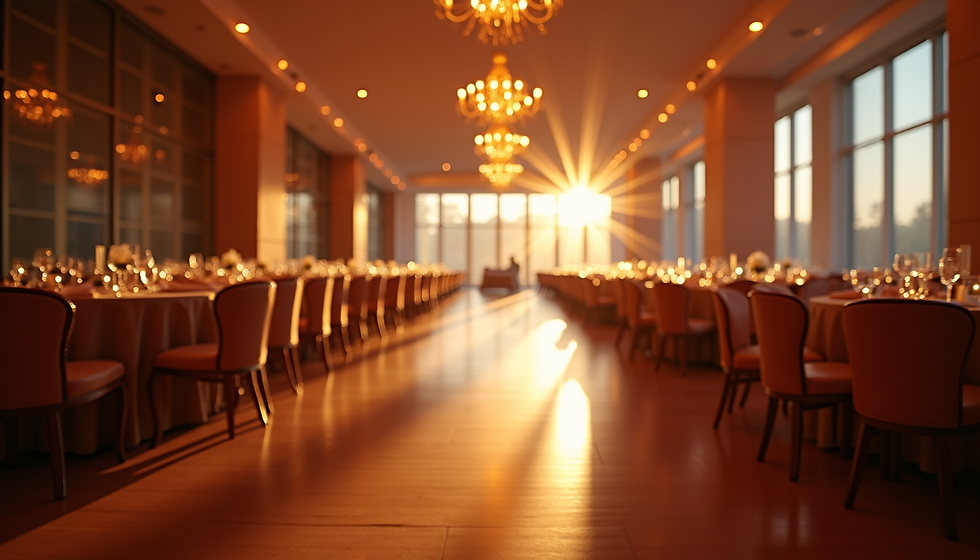Top Considerations for Planning Event Lighting
- coolrayzlighting
- Jun 22
- 4 min read
Lighting sets the mood for any event, transforming a simple gathering into a memorable experience. Whether you are hosting a wedding, corporate event, or outdoor festival, the right lighting can enhance your venue and create an enchanting atmosphere. In this blog post, we will delve into the top considerations for planning effective event lighting rental, ensuring that your event shines brightly.
Understanding Event Lighting Rental
When planning an event, the first step is to understand the different types of lighting available for rental. There are several options to choose from, each offering unique features and effects. Here are some popular choices:
Ambient Lighting: This is the general lighting that allows people to see and move around safely. It includes ceiling fixtures, chandeliers, and wall sconces. Ambient lighting sets the base for your event's illumination.
Task Lighting: This type of lighting focuses on specific areas, such as dining tables or stages, where activities take place. It can be achieved with spotlights or table lamps.
Accent Lighting: Accent lighting is used to highlight particular features or decorations, such as floral arrangements or architectural details. It adds depth and character to your event setting.
Decorative Lighting: This is purely aesthetic and includes string lights, lanterns, or LED installations that enhance the overall theme or vibe of your event.
Understanding these categories helps you to strategically choose your lighting rental options to meet the needs of your event.

Choosing the Right Color Temperature
Another important consideration is the color temperature of your lighting. The warmth or coolness of the light can influence the mood significantly. Here are key points to keep in mind:
Warm Light (2700K - 3000K): Ideal for weddings and celebratory events, this creates a cozy atmosphere.
Neutral Light (3500K - 4100K): Perfect for corporate functions, providing a clean and professional look.
Cool Light (5000K - 6500K): Best for contemporary themes and outdoor areas. It can evoke a crisp and energetic feel.
Choosing the proper color temperature for your event can evoke emotions and set an appropriate mood for your attendees.

Assessing Your Venue's Features
Every venue has unique attributes that can be used to your advantage when planning your lighting. Here are some aspects to assess:
Ceiling Height: If your venue has high ceilings, consider using uplighting to accentuate the height. Tall structures can create a dramatic effect.
Architectural Elements: Features like columns, arches, or beams can be highlighted with color washes or spotlights to add interest.
Proximity to Power Sources: Ensure you have adequate access to electrical outlets for your lighting setup. Positioning the lights around power sources will help minimize the use of extension cords, preventing potential trip hazards.
Outdoor Elements: If your event is outdoors, consider the natural lighting conditions. Alternative solutions like portable generators or solar lights may be needed to create a well-lit environment as night falls.
Assessing these venue features will guide your lighting choices, making the most of what the space has to offer.
Understanding Your Event Theme
Your lighting should align with the theme of your event. Start planning by considering these thematic elements:
Color Scheme: Use lighting to reinforce your color palette. If your event features blue and gold, select gel filters that correspond in your lighting rental options.
Style: An outdoor garden party may require soft, romantic lighting, while a tech-savvy corporate event might benefit from sleek, modern fixtures.
Season: Don’t forget to incorporate seasonal elements. For example, warm orange and red hues work beautifully for an autumn-themed event.
By aligning your lighting choices with your event's theme, you create a cohesive and visually appealing experience.

Scheduling and Timing Your Lighting Setup
A well-executed lighting plan does not only hinge on equipment and color choices; timing also plays a crucial role. Here are strategies to help:
Setup Time: Plan for sufficient time to install your lighting before guests arrive. This often involves not just setting up lights but also testing them to ensure proper functionality.
Lighting Changes: If your event has a special moment, such as a toast or a performance, schedule lighting changes accordingly. Coordinating these with a DJ or event planner can create a seamless experience.
Dimming Options: Consider incorporating dimmers that allow you to adjust the lighting over the course of the event. This versatility can dramatically enhance transitions during the celebration.
By considering timing and setup needs, you will ensure that everything is prepared and ready as your guests arrive, creating a smooth experience.
Final Thoughts on Planning Event Lighting Rental
Incorporating the right lighting for your event can elevate the entire experience, transforming mundane spaces into stunning backdrops. Consider the type of lighting you want to rent, the color temperature needed, the unique features of your venue, the event's theme, and the timing for setup.
By taking these considerations into account, your event lighting will contribute to an unforgettable atmosphere, encouraging guests to linger and enjoy the experience long after the event concludes.
For an excellent resource for your lighting needs, explore options for event lighting rental that suit your vision and budget. It’s time to illuminate your event with style!





Comments